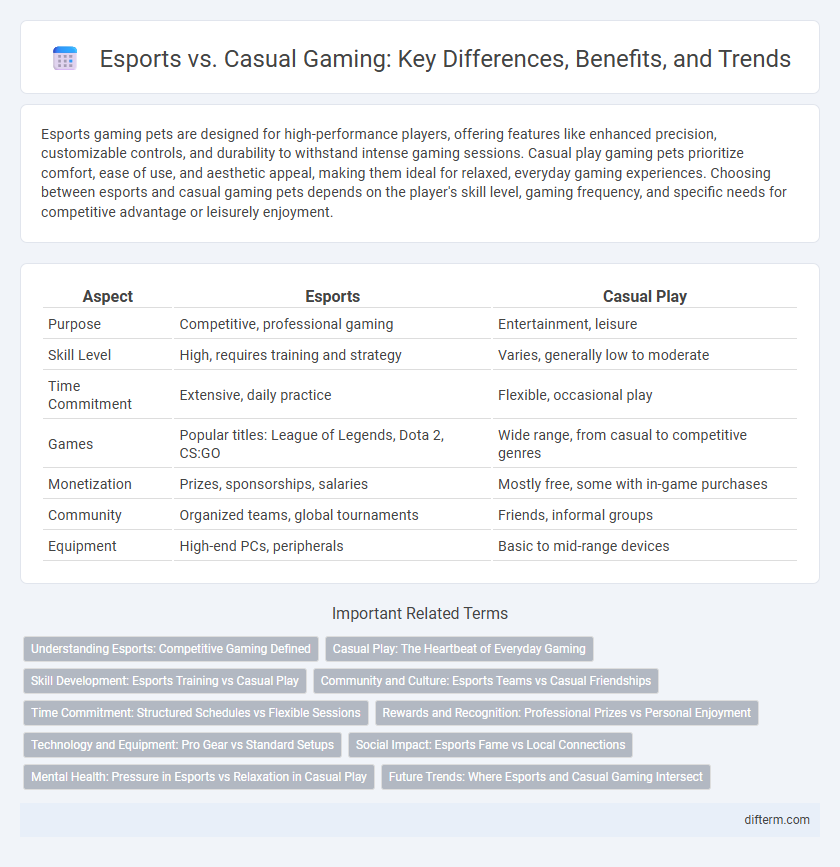Esports gaming pets are designed for high-performance players, offering features like enhanced precision, customizable controls, and durability to withstand intense gaming sessions. Casual play gaming pets prioritize comfort, ease of use, and aesthetic appeal, making them ideal for relaxed, everyday gaming experiences. Choosing between esports and casual gaming pets depends on the player's skill level, gaming frequency, and specific needs for competitive advantage or leisurely enjoyment.
Table of Comparison
| Aspect | Esports | Casual Play |
|---|---|---|
| Purpose | Competitive, professional gaming | Entertainment, leisure |
| Skill Level | High, requires training and strategy | Varies, generally low to moderate |
| Time Commitment | Extensive, daily practice | Flexible, occasional play |
| Games | Popular titles: League of Legends, Dota 2, CS:GO | Wide range, from casual to competitive genres |
| Monetization | Prizes, sponsorships, salaries | Mostly free, some with in-game purchases |
| Community | Organized teams, global tournaments | Friends, informal groups |
| Equipment | High-end PCs, peripherals | Basic to mid-range devices |
Understanding Esports: Competitive Gaming Defined
Esports is a structured form of competitive gaming where players or teams compete in organized tournaments with defined rules, prize pools, and professional regulations. Unlike casual play, esports emphasizes skill mastery, strategic depth, and adherence to game mechanics at an elite level, often streamed to global audiences. Key titles such as League of Legends, Dota 2, and Counter-Strike illustrate the high-stakes environment and dynamic meta characteristic of the esports ecosystem.
Casual Play: The Heartbeat of Everyday Gaming
Casual play fuels the daily pulse of gaming by offering accessible, low-pressure experiences that attract a broad audience beyond competitive esports circles. It fosters social connections and stress relief through games that emphasize fun and creativity rather than high-stakes competition. Casual play's adaptability across diverse platforms and genres ensures its enduring role as the cornerstone of everyday gaming culture.
Skill Development: Esports Training vs Casual Play
Esports training emphasizes structured skill development through deliberate practice, strategic analysis, and competitive scenarios that enhance decision-making, reflexes, and teamwork. Casual play provides a more relaxed environment, fostering general hand-eye coordination and entertainment but often lacks the intensity and focus required for high-level skill acquisition. Consistent esports training results in measurable improvements in reaction times, game sense, and tactical execution unmatched by casual gameplay.
Community and Culture: Esports Teams vs Casual Friendships
Esports teams foster a competitive community centered on strategic collaboration, professional growth, and global recognition. Casual friendships in gaming emphasize relaxed social interaction, shared enjoyment, and inclusive participation without performance pressure. The distinct culture of esports builds intense loyalty and brand identity, while casual play nurtures spontaneous connections and broad accessibility.
Time Commitment: Structured Schedules vs Flexible Sessions
Esports demands rigorous time commitment with structured schedules for training, tournaments, and team coordination, ensuring consistent performance improvement. Casual play offers flexible sessions tailored to individual availability, allowing spontaneous gaming without strict time constraints. The contrast in time management highlights the dedication required for competitive success versus the leisurely approach of casual gamers.
Rewards and Recognition: Professional Prizes vs Personal Enjoyment
Esports players compete for substantial cash prizes, sponsorships, and global recognition, elevating their status within the gaming community and beyond. Casual players prioritize personal enjoyment, stress relief, and social interaction without the pressure of competitive rankings or financial rewards. The distinction between professional rewards and casual satisfaction highlights how gaming can serve both as a career and a leisure activity.
Technology and Equipment: Pro Gear vs Standard Setups
Esports athletes rely on high-performance rigs with ultra-low latency monitors, mechanical keyboards, and precision gaming mice to maximize responsiveness and accuracy, while casual players typically use standard setups that prioritize comfort over speed. Professional gear includes customizable peripherals and specialized audio systems designed for competitive advantage, contrasting with the basic hardware commonly found in non-competitive play. The technology gap between esports hardware and casual setups significantly impacts gameplay quality, reaction times, and overall player experience.
Social Impact: Esports Fame vs Local Connections
Esports fosters global social networks by connecting millions of players and fans through competitive tournaments and live streaming platforms such as Twitch and YouTube Gaming. Casual play, however, emphasizes local and in-person interactions, strengthening community bonds and friendships within neighborhoods and small groups. The social impact of esports lies in creating widespread recognition and digital camaraderie, while casual play maintains intimate, real-world relationships.
Mental Health: Pressure in Esports vs Relaxation in Casual Play
Esports players often face intense pressure from high-stakes competitions, leading to increased stress and potential burnout, whereas casual gaming promotes relaxation and stress relief by offering a low-pressure environment. The competitive nature of esports demands constant performance optimization, increasing risks of anxiety and mental fatigue. In contrast, casual play encourages social interaction and enjoyment, fostering positive mental health and relaxation.
Future Trends: Where Esports and Casual Gaming Intersect
Esports and casual gaming are converging through advancements in cloud gaming and cross-platform play, enabling seamless access to competitive and social experiences. AI-driven personalization enhances player engagement by tailoring challenges and content to individual skill levels, blurring the lines between professional competition and casual enjoyment. Emerging technologies like virtual reality and augmented reality further integrate immersive esports elements into casual gaming, shaping a future where both communities coexist and evolve together.
Esports vs Casual Play Infographic

 difterm.com
difterm.com